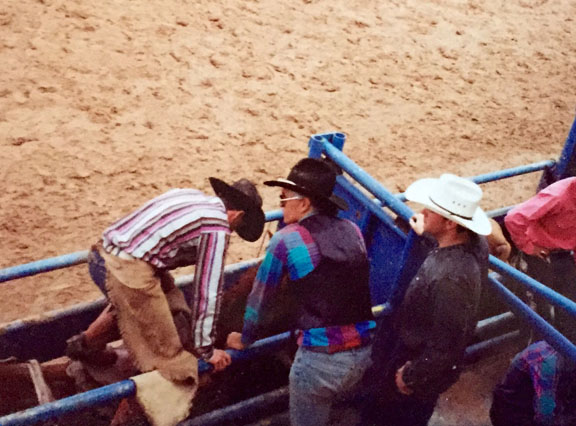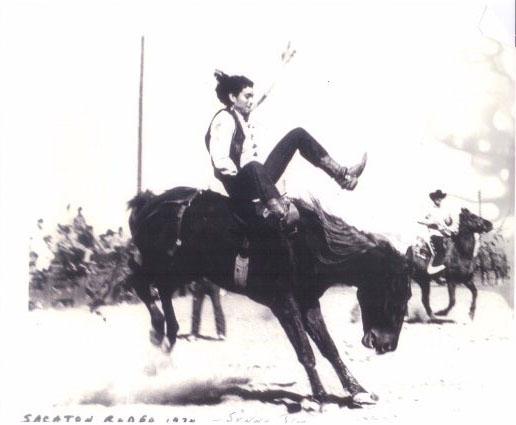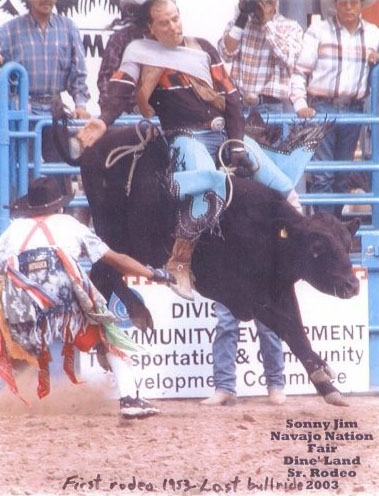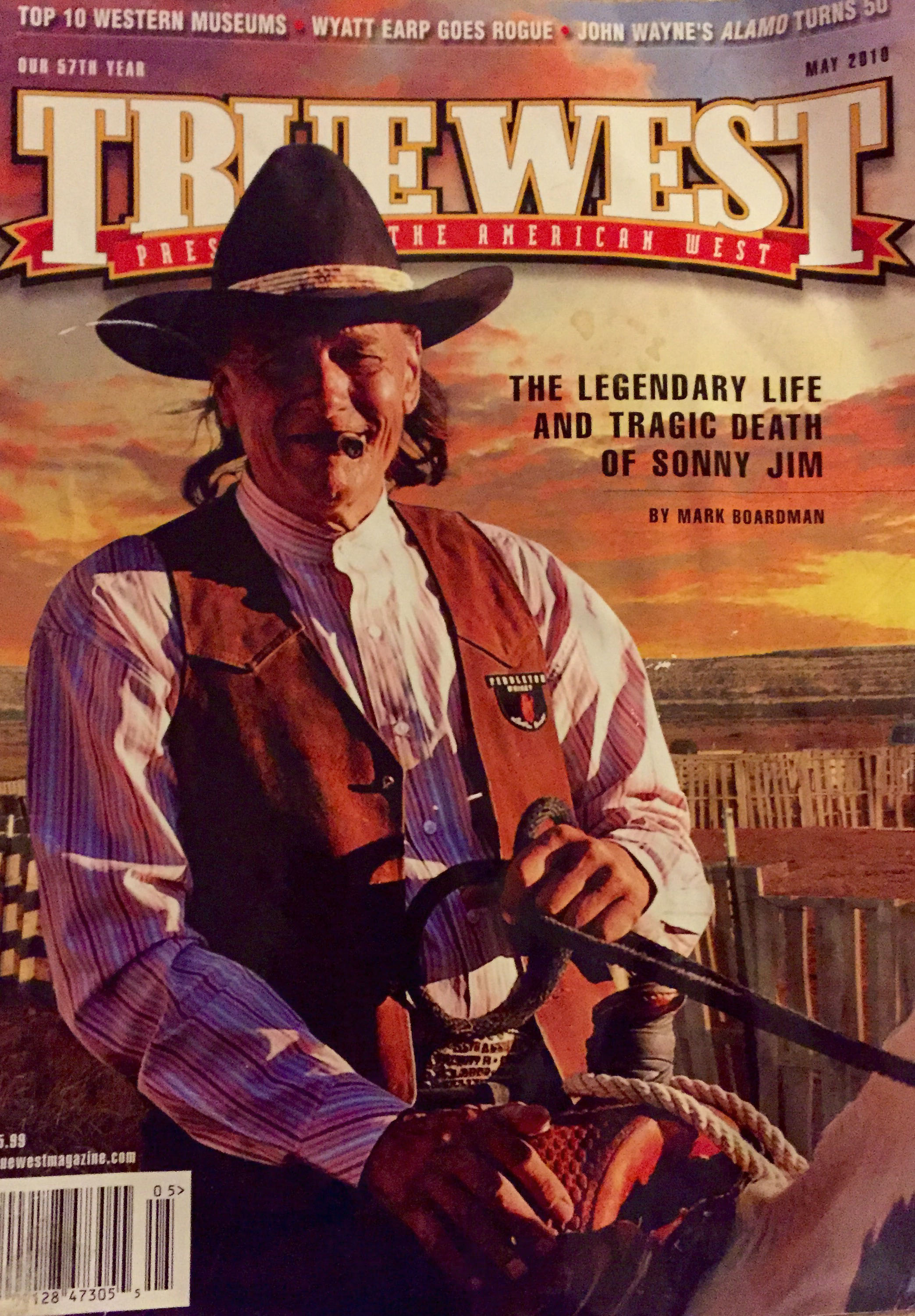HOME
The Natural Horseman – Under the moonlight
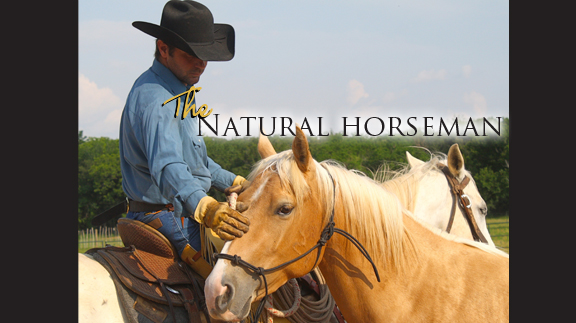
By Steve Stevens
I was awoken by a tall shadow standing over me, kicking me in my side through the canvas bedroll I found myself sleeping in.
“Time to get up,” came the quiet voice. I tried to clean the crud out of my sleepy eyes. The bunk house was dark except for the bright New Mexico moonlight shining through the curtains.
All I could see was a silhouette of the tall thin man standing over me and his big brimmed cowboy hat.
I could see and smell the burn from the red swisher sweet cigar he was smoking. I asked what time it was. He replied, “Time to get up. And make sure you make your bed. It keeps the spirits happy”.
Could this be a dream? I had just drove from southern California to Gallup, New Mexico. All day.
Had been shown around this giant ranch by a strange man I hadn’t met but once weeks before.
He went by the name Sonny Jim.
He was Modoc Indian, but spent most of his time around the Navajo Nation. I knew he had been a great rodeo cowboy and our mutual acquaintance, Kenny told me he was tough as nails. I had met Sonny for a few moments weeks before at one of my first rodeos, and he invited me up to Gallup to teach me how to ride bucking horses. At the time it had seemed like a good idea. At 19 years old I had never left home on my own. So, why not go stay with a strange man on the Indian Reservation?
“Hurry up, we don’t have much time left.”
“Time left for what?” I asked.
“The best way to ride bucking horses” he said.
I was frustrated now, being awoken and with all the riddles.
“There is no better way to ride bucking horses than under the moonlight”.
I laughed at him, surely this must be a joke.
He made no acknowledgment to my nervous gesture and went out the door.
I threw on my jeans and boots and chased after him. He walked a ways through the New Mexico desert landscape. Maybe a quarter of a mile through the piñon trees not saying a word.
I said, “you’re just hazing me right?”
He just kept walking.
I realized right then and there I was not in Kansas anymore.
We were in the middle of nowhere. Nobody was around.
Other than the moonlight I was in the middle of nowhere with this strange man. I had trouble keeping up with Sonny’s long stride. I asked him where we were going. He said, “You talk too much, you are going to upset the spirits.”
We arrived at a an old wooden round pen with a bucking chute in it. There were some other square pens around it, filled with horses. Rangy horses. Horses that looked like they hadn’t seen many humans. You could see the white of their eyes glistening off the big moon. The dirt they kicked up seemed more like fog from some Lon Chaney Vampire movie.
Sonny walked into the horse pen. He grabbed a wild looking appaloosa, maybe mustang cross, with the ease of a professional ballerina. He walked by me and said matter of factly, “we might as well start with the toughest one first and work our way back”.
I didn’t know if he was serious, since the app was so easy to catch.
He loaded the bronc in the chute. He then went over how to saddle, how to get on, and what to do before I nodded my head.
He told me to get on.
This was not a question, more of an order.
So I climbed down on the bronc. Inside the chute was dark and I could barely see my boots to put on my stirrups. The horse trembled or maybe it was me…hard to tell and hard to remember. The app kept reaching back towards my right toe.
The next thing that happened was kind of like when you are at a park and a football hits you in the back of the head. You never see it coming till it is too late.
I squealed in pain.
The horse had bit down on my toes and wouldn’t let go. I kicked and yelled and all at once the horse started bucking in the chute. Then throwing me out of the chute. Sonny caught me with one hand keeping me from completely falling to the ground.
What had I gotten myself into.
This was crazy. It was the middle of the night. There are no fans watching the rodeo, no pick up man, no one. I was left to survive like I was in the wilderness naked. Except there was Sonny.
At the time I couldn’t decide if he was my guide or a grizzly bear. I was scared, my toe ached and I knew I had bitten off more than I could chew.
Sonny said, “Get back on.” I blurted back, “You’re crazy. You get on”.
I couldn’t believe I talked back to this man I barely knew like that. It wasn’t the way I was raised. Sonny, probably about fifty at the time, stared into my eyes.
It was hard to keep his gaze as his eyes looked pure black under the moonlight.
He had a little grin and said “Ok”.
He climbed down on the bronc like a pack of tigers on a wildebeest.
He looked at me and said, “if you want to do this, you need to learn to relax”.
He jabbed the bronc in the sides with his spurs to make him buck again in the chute. The horse snorted and jumped and kicked in the chute. Sonny spoke to me calm and deliberate as the horse bounced off the panels, never missing a beat, like he was born on the back of a horse.
“This stuff isn’t for sissies. You need to learn how to enjoy the moment”.
His eyes were steel. I had never seen a man like this except in the movies.
He was a super hero. Tough as nails.
I knew right then and there, that I admired this man. Scared to death of him, but admired him.
So I got back on. Mustered up all the courage I could find and in the shadows of the moonlight I nodded my head. Sonny opened the chute gate. And the little app loped out of the chute into the round pen never bucking or kicking at all. I rode five more wild horses that night. Went on to get on 75 broncs that week. Most of them right there in that old wooden round pen and a handful at rodeo arenas around the reservation.
Over the next fifteen years I spent a lot of time with Sonny. He taught me about rodeoing, horses, being a cowboy, our Native American culture and most importantly, he laid some of the foundation of me transforming from a boy to a man.
Steve and Sonny at a rodeo. (Photo courtesy of Steve Stevens)
On October 23rd, 2009, at the age of 68, Sonny was murdered in a gun fight.
Sonny was doing what he always did. Helping a friend in need.
My son Ryder’s middle name is “James” named after my dear friend Sonny James.
When I get on a problem horse, or a colt, or things get a little western, I know Sonny is riding with me. With that little grin he had, enjoying watching a young cowboy grow. Not only under the saddle but through life.
When you get a chance to have a conversation with these old cowboys that have seen the world change from wide open prairies to giant suburbs, men that have spent a lifetime learning about horses and cattle, that have worked from sun up to sun down every day with pride, that have lived ten lifetimes celebrating their western heritage, take the time and listen to every word. Watch every smile, every twinkle in their eye.
Sonny bareback riding. (Photo courtesy Steve Stevens)
Before long, their knowledge and experience will only be found in old cowboy movies or in books.
Honor your cowboy heritage and take the time to listen to whatever they have to say.
It might be the most important thing you are ever told.
P.S.
Sonny Jim lived quite a life.
He traveled to Asia playing basketball with the Harlem Globetrotters in the early 60’s.
He played back up guitar for both Willie and Waylon in the early 70’s
He was the All Around Indian Rodeo Cowboy in 1969 and 1970.
He was the Bareback Riding Champion 1970.
In 1982 he won the Steer Wrestling World Championship.
Sonny continued riding bulls into his 50’s.
Sonny’s last bull ride. (Photo courtesy of the Steve Stevens)
After Sonny’s passing, the magazine “True West” had him on the cover. In the same magazine they talked about Wyatt Earp and John Wayne and I know that would have made him proud.
I know that Sonny is in heaven watching over me and my family, riding the wildest bronc he could find with a big grin on his face.
I miss you so much dear friend.
Sonny on the cover of True West. (Photo courtesy of Steve Stevens)
HOME
Farm and Ranch Injuries
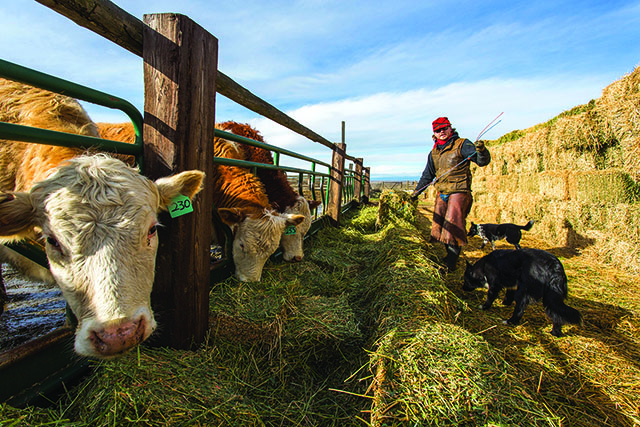
By Barry Whitworth, DVM
In January, I attended the Oklahoma Veterinary Conference. While waiting for one of the sessions to start, a classmate of mine commented how many of the attendees walk with a limp, used a cane, and/or have damaged hands. We all agreed that working with animals is hard on the body. In general, anything associated with farming and ranching is dangerous.
Most farmers and ranchers know that agriculture is a dangerous occupation. According to United States Bureau of Statistics, workers involved in agriculture, forestry, and fishing had the highest occupational fatality rate in 2022. The fatality rate of 23.5 per 100,000 full-time equivalent (FTE) workers for this group is much higher when compared to the overall occupation fatality rate of 3.7 per 100,000 FTE. Most of the agriculture-related fatalities are associated with transportation, such as tractor overturns, and vehicle crashes, but a fair number involve livestock.
To read more, pick up a copy of the March issue of NTFR magazine. To subscribe by mail, call 940-872-5922.
HOME
Jesses Jewelz

By Jesse Kader
Comfy and keep it western. That’s the name of the game this month. It’s hot and who wants clingy clothing? This jumpsuit is perfectly comfortable and relaxed without forfeiting the fashion. Dress it up or keep it casual. See this and more at www.jessesjewelz.com.
HOME
Noble Research Institute Expands New Program Offering Farmers and Ranchers the Essentials of Regenerative Ranch Management
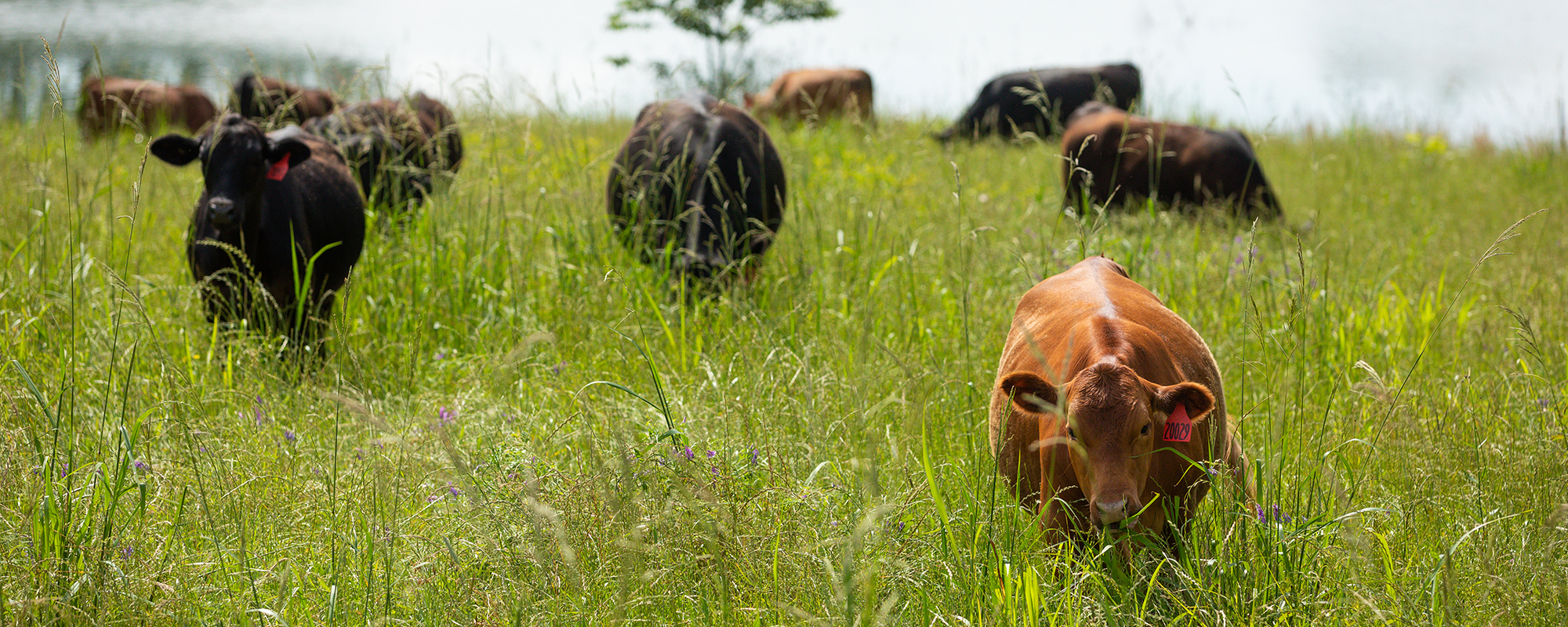
The educational program has been expanded to three new locations, empowering ranchers and farmers to monitor and improve the health of their land, livestock and livelihood through regenerative principles.
ARDMORE, OK–September 12, 2023 – Noble Research Institute announced the expansion of Essentials of Regenerative Ranching, a new educational program designed to help ranchers enhance and restore the land, making it more resilient and reaching livestock grazing goals through regenerative management. Essentials of Regenerative Ranching provides producers with practical tools, hands-on experience and guidance to make data-driven decisions to decrease costs and improve profit.
The Essentials of Regenerative Ranching course has been expanded to three new locations in Texas and Oklahoma. Registration is open now at www.noble.org/essentials. Seating is limited, so early registration is recommended.
Texas A&M
College Station, Texas
October 17 – 18
O.D. Butler, Jr. Animal Science Complex
Noble Research Institute
Ardmore, Oklahoma
October 31 – November 1
Pavilion Center
Texas A&M
Kingsville, Texas
November 7-8
Caesar Kleberg Wildlife Center
“Program participants gain working knowledge and experience of monitoring and improving the health of their soil, grazing livestock more strategically and making informed financial decisions,” said Hugh Aljoe, Noble Research Institute’s director of ranches, outreach and partnerships. “We use a mix of classroom and field work to send producers home with the tools they need to begin making changes on their ranch.”
Farmers and ranchers navigate uncertainty from weather, fluctuating market prices and escalating costs of inputs. Many producers are seeking new tools that offer greater control and reduce their operational uncertainty. Through this course, ranchers and farmers will calculate their financial situations, determine initial stocking rates, carrying capacity and grazing goals.
“The course is well-suited for ranchers of all experience levels and all types and sizes of operations,” Aljoe added. “No matter your situation, this program will transform the way you think about your ranch.”
The Essentials of Regenerative Ranching program allows producers to overcome obstacles, become more informed problem-solvers and increase the productivity of their grazing lands. By participating in this program, ranchers join a community of like-minded producers who are shaping the future of ranching and leaving a lasting impact on their land and families. “If I had known what I learned in this course when I started my regenerative journey, I could have avoided some key mistakes,” said Tana McCarter, a rancher, and Essentials attendee. “I left with the tools I needed to monitor my soil health and financial progress. I’ll now have the right data to make informed decisions on how to meet my regenerative goals.”
Noble Research Institute is an independent nonprofit agricultural research organization dedicated to guiding farmers and ranchers in applying regenerative principles that yield healthier soil, more productive grazing land, and business success.
At Noble, researchers, facilitators and ranch staff work together to share with farmers and ranchers the skills and tools to regenerate the land in a profitable manner. Noble is focused on the regenerative management of the nation’s grazing acres, which directly impacts pasture and range environments, wildlife, pecan production, and livestock production. Regenerative management recognizes that each decision made on the ranch impacts the interactions of the soil, plants, water, animals, economics and people. Noble’s 14,000 acres of working ranch lands provide a living laboratory on which to demonstrate and practice regenerative principles and ideas to deliver value to farmers and ranchers across the U.S.
-

 Country Lifestyles1 year ago
Country Lifestyles1 year agoScott & Stacey Schumacher: A Growth Mindset
-

 Equine7 months ago
Equine7 months agoThe Will to Win
-

 Country Lifestyles7 years ago
Country Lifestyles7 years agoStyle Your Profile – What your style cowboy hat says about you and new trends in 2017
-

 Country Lifestyles4 years ago
Country Lifestyles4 years agoAmber Crawford, Breakaway Roper
-

 HOME7 years ago
HOME7 years agoGrazing North Texas – Wilman Lovegrass
-

 Country Lifestyles7 years ago
Country Lifestyles7 years agoDecember 2016 Profile, Rusty Riddle – The Riddle Way
-

 Country Lifestyles8 years ago
Country Lifestyles8 years agoJune 2016 Profile – The man behind the mic: Bob Tallman
-

 Outdoor9 years ago
Outdoor9 years agoButtercup or Primrose?

